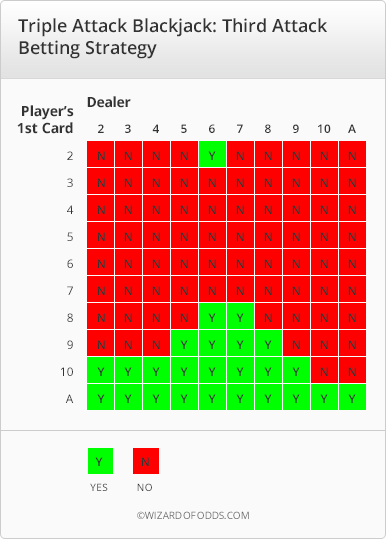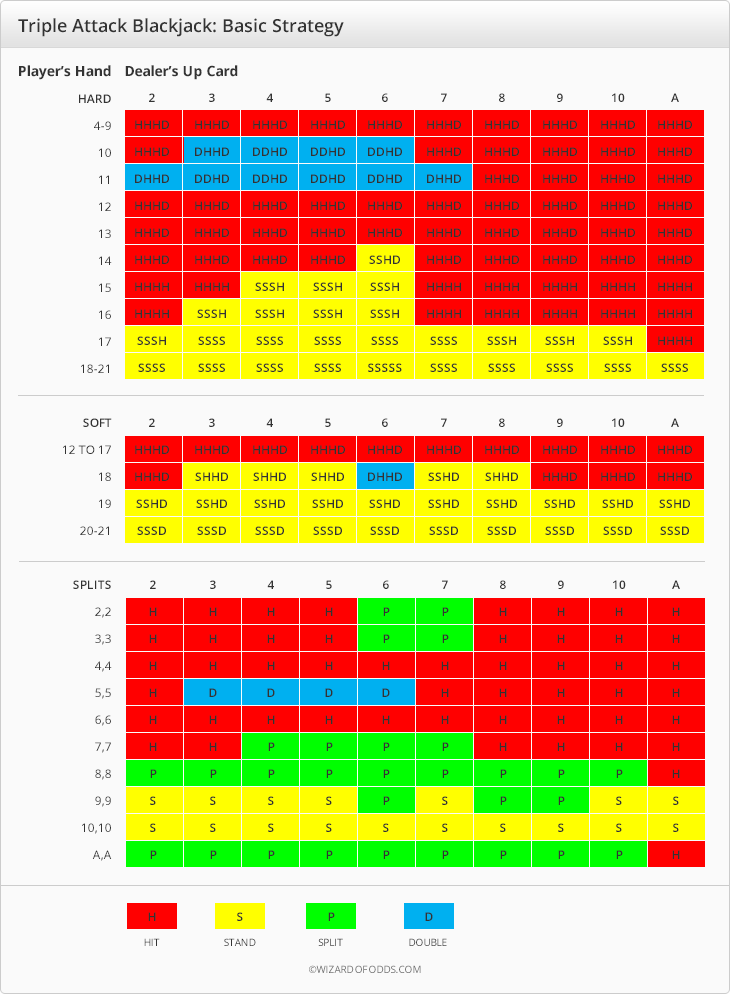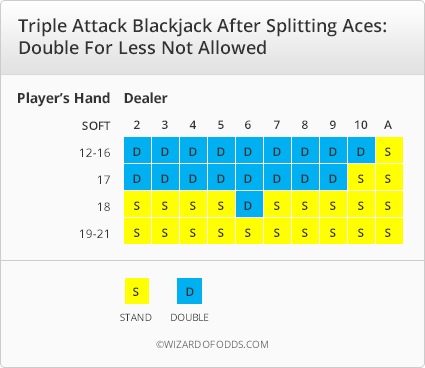On this page
Triple Attack Blackjack
Introduction
Triple Attack Blackjack is a blackjack variant I noticed at Harrah's Las Vegas on August 17, 2010. It also won the best new table game award at the 2010 Raving Consulting conference on casino table games.
The thrust of the game is that you can add to your bet after you see your first card, and then add to it again after you see the dealer's up card. Of course, other rules were changed to pay for those options. I played it for about half an hour and found it quite fun. At times I was perplexed on whether to increase my bet or how to play my cards. The strategy is quite a bit different from conventional blackjack, as I would later confirm.
Rules
The rules are the same as blackjack, except as noted below.
- Eight 48-card Spanish decks are used. Spanish decks have the tens removed.
- The player makes a "first attack" wager.
- The dealer gives each player his first card.
- The player has the option to make a "second attack" wager, which, if made, must be equal to the "first attack" wager.
- The dealer will deal himself his first card face up.
- The player has the option to make a "third attack" wager, which, if made, must be equal to the "first attack" wager. Note that making a "second attack" wager is not required to make a "third attack" wager.
- The dealer will deal the player and himself a second card. The dealer's second card will be dealt face down.
- If the dealer has an ace up, then he will offer insurance. Winning insurance wagers pay 5 to 1 for a suited blackjack, and 2 to 1 for a non-suited blackjack.
- Player blackjacks pay even money, including when the dealer also has a blackjack.
- If the dealer has a winning blackjack, then the player will lose all attack wagers made.
- If the player double or splits, he should double the amount bet for each attack wager.
- The player may double on any number of cards, and after a split.
- The player may re-split aces.
- The player may double or stand only after splitting aces. The game owner, Galaxy Gaming, did not intend for double for less to be allowed, but it wouldn't hurt to try.
- If the player gets to six cards without busting, then he shall automatically win (known as the six-card Charlie rule). I assume this is true after splitting but am not positive.
- The dealer shall hit a soft 17.
- If the dealer busts with 22, then any remaining player wagers shall push.
Betting Strategy
The player should make the second attack wager with a 10 or ace only.
The following table shows when the player should make the third attack wager (Y=Yes, make the third attack, N=No, don't).

Playing Strategy
Triple Attack Blackjack calls for a three-dimensional strategy, based on the total points of the player's cards, the number of player cards, and the dealer's up card. To use the strategy table below, look up the player's hand along the left column and the dealer's card along the top column. Except for splitting, each cell will have four letters. The first, staring from the left, denotes what to do with 2 cards, the second letter with 3, the third with 4, and the fourth with 5. The standard key is used, where H=Hit, S=Stand, D=Double, and P=Split.

As stated in the rules, after splitting aces the player will get one more card and then has the following options: (1) stand, (2) double, (3) re-split with another ace. However, ask if you can double for less. If the dealer says "no," then use the top table below, if he says "yes," then use the bottom one. In the lower table "DL" stands for double for less. In those situations, double for as little as possible, preferably just one penny.


Odds
According to my analysis, the house edge is 1.17%, assuming double for less after splitting aces is not allowed. That is the ratio of what the player can expect to lose overall to the initial wager. The average final wager is 1.63 times the original wager. So the element of risk, the ratio of expected loss to the total amount bet, is 0.72%.
If double for less after splitting aces is allowed, then the house edge is 0.86%, and the element of risk is 0.53%.
Side Bets
Triple Attack Blackjack has three side bets to choose from. Here is a brief description of each.- Suited Royals: Pays if your first two cards are suited. Premium wins for a royal match or suited face cards. House edge of 3.13%.
- Triple Match: Pays based on your first two cards and dealer's up card. House edge of 5.69%.
- Insurance: The same as insurance in blackjack, except a suited blackjack pays 5 to 1. This is possible because of the lower probability that the hole card is a 10 with Spanish decks. House edge of 6.01%.
The following three return tables show the probability and contribution to the return of each event for all three side bets.
Suited Royals
| Event | Pays | Combinations | Probability | Return |
|---|---|---|---|---|
| Suited KQ | 40 | 256 | 0.003481 | 0.139252 |
| Suited face cards | 10 | 848 | 0.011532 | 0.115318 |
| Any other two suited cards | 2 | 17136 | 0.233029 | 0.466057 |
| Loser | -1 | 55296 | 0.751958 | -0.751958 |
| Total | 73536 | 1.000000 | -0.031332 |
Triple Match
| Event | Pays | Combinations | Probability | Return |
|---|---|---|---|---|
| Suited three of a kind | 150 | 2688 | 0.000287 | 0.043060 |
| Three of a kind | 20 | 56832 | 0.006069 | 0.121389 |
| Suited pair | 4 | 473088 | 0.050524 | 0.202097 |
| Any pair | 2 | 1622016 | 0.173226 | 0.346452 |
| Loser | -1 | 7208960 | 0.769893 | -0.769893 |
| Total | 9363584 | 1.000000 | -0.056894 |
Insurance Return Table
| Event | Pays | Combinations | Probability | Return |
|---|---|---|---|---|
| Suited BJ | 5 | 24 | 0.062663 | 0.313316 |
| Non-suited BJ | 2 | 72 | 0.187990 | 0.375979 |
| No BJ | -1 | 287 | 0.749347 | -0.749347 |
| Total | 383 | 1.000000 | -0.060052 |
Methodology and Acknowledgements
My own analysis was done based on an infinite number of decks and infinite re-splitting. Galaxy Gaming, the game owners, kindly supplied me with their own math report on the game by Cindy Liu. Cindy's analysis was combinatorial and based on a true eight deck game, resulting in a 1.18% house edge. Cindy was also helpful supplying other information not indicated in the report, and with my questions about her report. So I would like to thank Galaxy Gaming and Cindy Liu for their help.


